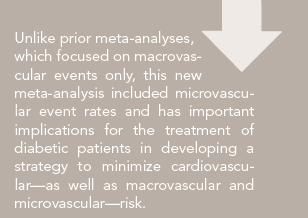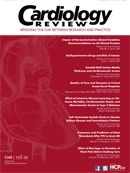Publication
Article
Cardiology Review® Online
Effect of Intensive Glucose Lowering on All-Cause Mortality, Cardiovascular Death, and Microvascular Events in Type 2 Diabetes
Author(s):


Saurav Chatterjee, MD
REVIEW
Boussageon R, Bejan-Angoulvant T, Saadatian-Elahi M, et al. Effect of intensive glucose lowering treatment on all cause mortality, cardiovascular death, and microvascular events in type 2 diabetes: meta-analysis of randomised controlled trials. BMJ. 2011;343:d4169. doi: 10.1136/bmj.d4169.
T
he study by Boussageon et al1 has important implications for the treatment of diabetic patients in developing a strategy to minimize cardiovascular, as well as macro- and microvascular risk. Intensive blood glucose control is often a preferred strategy to minimize macro- and microvascular events, especially in type 2 diabetics,2 despite the accumulation of data and meta-analyses suggesting its limited benefits in reduction of events.3,4 However, prior meta-analyses focused on macrovascular events only, while the study by Boussageon and colleagues included microvascular event rates, contributing to its novelty.
Study Details
The methodology was sound, following standard protocols for a meta-analysis to examine event rates for intensive control of blood glucose in adults with type 2 diabetes using both insulin and oral hypoglycemics. The authors used the Jadad score to analyze the quality of studies used, which has been criticized as overly simplistic and inaccurate for the purpose of classification of study quality.5,6
Primary end points were all-cause mortality and death from cardiovascular causes. Secondary end points were myocardial infarction, non-fatal myocardial infarction, stroke (fatal and non-fatal), congestive heart failure, photocoagulation, retinopathy (new or worsening), visual deterioration or blindness, neuropathy (new or worsening), microalbuminuria (new or worsening), renal failure (occurrence of renal failure or doubling of serum creatinine level), peripheral vascular events (leg revascularization, peripheral arterial disease, or intermittent claudication), amputation, and severe hypoglycemia corresponding to those reported in the originally published papers.
The authors used the more stringent 99% confidence interval (CI) instead of the commonly used 95% level; they also altered the usual order of tests assessing statistical heterogeneity across trials— using random effects models for studies with unknown heterogeneity and then using a fixed-effects model once heterogeneity was assessed and found to be low. Another addition made to enhance the quality of the study was inclusion of calculation of absolute risk reduction and number needed to treat (NNT). The authors provided information about the excluded studies and the reasons for their exclusion. In total, 18,315 patients were randomized to the intensive treatment group and 16,218 to the standard treatment group. The mean duration of follow-up was 5.0 years (range, 1-10 years). Intensive treatment did not significantly affect all-cause mortality (risk ratio [RR], 1.04; 99% CI, 0.91-1.19) or death from cardiovascular causes (RR, 1.11; CI, 0.86-1.43), even when analysis was restricted to highquality trials. Intensive treatment also did not reduce microvascular complications.
The risk of severe hypoglycemia was more than twice as high in the intensive treatment group (RR, 2.33; CI, 1.62- 3.36). Absolute 5-year risk increases in severe hypoglycemia ranged from 1.9% to 6.6%, making the number of patients who needed to be treated to provoke an event between 52 and 15. There was no significant reduction in myocardial infarctions; there was actually an increase in the risk of congestive heart failure. Neither was there any benefit noted with the incidence of microvascular complications. This meta-analysis found that intensive glucose lowering was not associated with improvement in hard clinical outcomes—neither macronor microvascular.
References
1. Boussageon R, Bejan-Angoulvant T, Saadatian-Elahi M, et al. Effect of intensive glucose lowering treatment on all cause mortality, cardiovascular death, and microvascular events in type 2 diabetes: meta-analysis of randomised controlled trials. BMJ. 2011;343:d4169. doi: 10.1136/bmj.d4169.
2. Nathan DM, Buse JB, Davidson MB, et al. Medical management of hyperglycemia in type 2 diabetes: a consensus algorithm for the initiation and adjustment of therapy: a consensus statement of the American Diabetes Association and the European Association for the Study of Diabetes. Diabetes Care. 2009;32:193-203.
3. Action to Control Cardiovascular Risk in Diabetes Study Group; Gerstein HC, Miller ME, Byington RP, et al. Effects of intensive glucose lowering in type 2 diabetes. N Engl J Med. 2008;358:2545-2559.
4. Ray KK, Seshasai SR, Wijesuriya S, et al. Effect of intensive control of glucose on cardiovascular outcomes and death in patients with diabetes mellitus: a meta-analysis of randomised controlled trials. Lancet. 2009;373:1765-1772.
5. Berger VW. Is the Jadad score the proper evaluation of trials? J Rheumatol. 2006; 33:1710—1712.
6. Clark HD, Wells GA, Huet C, McAlister FA. Assessing the quality of randomized trials: reliability of the Jadad scale. Control Clin Trials. 1999;20:448-452.
7. Shukla VK, Bai A, Milne S, Wells G. Systematic review of quality assessment instruments for randomized control trials: selection of SIGN50 methodological checklist. The Cochrane Collaboration. http://www. imbi.uni-freiburg.de/OJS/cca/index.php/cca/ article/viewArticle/5053. Accessed September 19, 2011.
8. Dormandy JA, Charbonnel B, Eckland DJ, et al; PROactive Investigators. Secondary prevention of macrovascular events in patients with type 2 diabetes in the PROactive Study (PROspective pioglitAzone Clinical Trial In macroVascular Events): a randomised controlled trial. Lancet. 2005;366:1279-1289.
9. Tzoulaki I, Molokhia M, Curcin V, et al. Risk of cardiovascular disease and all cause mortality among patients with type 2 diabetes prescribed oral antidiabetes drugs: retrospective cohort study using UK general practice research database. BMJ. 2009;339:b4731.
10. Nissen SE, Wolski K. Effect of rosiglitazone on the risk of myocardial infarction and death from cardiovascular causes. N Engl J Med. 2007;356:2457-2471.
11. Gamble JM, Simpson SH, Eurich DT, Majumdar SR, Johnson JA. Insulin use and increased risk of mortality in type 2 diabetes: a cohort study. Diabetes Obes Metab. 2010;12:47-53.
12. Cooper-DeHoff RM, Egelund EF, Pepine CJ. Blood pressure lowering in patients with diabetes--one level might not fit all. Nat Rev Cardiol. [published online ahead of print November 16, 2011] 2011;8:42-49.
COMMENTARY
Comparing Apples With Oranges?
B
oussageon et al present us with a well-conducted meta-analysis of clinical trials assessing the effects of intensive glucose lowering with macro- and microvascular clinical end points, showing no significant benefits resulted with the strategy. However, a few interesting points merit consideration.
The authors used the Jadad score to assess and evaluate quality of trials instead of the more prevalent and accepted Cochrane metrics.7 It remains open to conjecture whether a reclassification of trial quality might have affected the outcomes. In addition, the authors performed assessment of risk ratios using 99% confidence intervals instead of the traditional 95%, which might have negatively influenced outcomes that might have been statistically borderline.
The authors focused on the strategy of intensive glucose reduction and did not stratify the analysis according to the medications used for achieving the same. It may well be a case of comparing apples with oranges when the authors themselves mention that using metformin as first-line therapy yields vastly different outcomes compared with sulfonylureas. Additionally, the risk of thiazolidinediones have been well documented in causing exacerbation of heart failure,8-10 and intensive glucose lowering with insulin has often been implicated in causing increased mortality by increasing risk of hypoglycemia.11
It would have been interesting for the authors to have performed an analysis by medication used to achieve the intensive glucose control. Of course, as the authors note in their conclusion, we await the results of studies of glucose reduction with the newer and safer DPP-4 inhibitors as well as the incretin analogs, with a more pragmatic approach with the older medications in reducing clinical events. Indeed, it seems plausible that glucose reduction may follow a curve similar to the J-shaped curve of events associated with blood pressure control, irrespective of the modality used to achieve target levels.12
About the Author
Saurav Chatterjee, MD, is a Resident in internal medicine at Maimonides Medical Center in New York, NY. He graduated from Calcutta National Medical College with honors and was a Resident in cardiology in Mercy Hospital, Kolkata, India, as well as trial coordinator of the CRESCENDO trial in Kolkata, India. Dr Chatterjee is involved in ongoing research and has been published in a variety of peer-reviewed journals. He is the recipient of the 2011 American Association of Cardiologists of Indian Origin Young Investigator Award for Interventional Cardiology and Electrophysiology.
